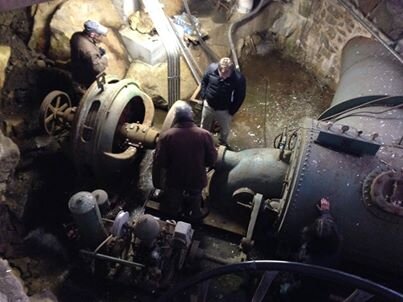Watershed Year for Cheshire Mills Hydro Project
Cheshire Mills Rope Drive, 1938
On June 4, 2013, the Federal Energy Regulatory Commission (FERC) issued an order allowing Historic Harrisville Inc. to redevelop the hydroelectric capability that powered Cheshire Mills for nearly 100 years. The approval came in the form of an Exemption from Licensing, based on the fact that the project is small (under 5 megawatts) and uses an existing dam. Winning approval was a 3-year-plus process.
The development of waterpower in Harrisville began in 1774, when Abel Twitchell harnessed a portion of the “v flow” to power a grist and sawmill. From the opening of the Cheshire Mills in 1851 until 1947, when electricity was purchased to provide all motive power, water provided the majority of power for manufacturing on this site.
HHI Energy Committee inspecting the turbine
Since easily harnessed waterpower made the existence of Harrisville possible, it is desirable that the waterways, dams and other waterpower features be preserved. Ideally, these features should be restored to their functional meaning for their significant historic value. In 2009, the historic significance of waterpower in Harrisville, the possibility of reusing existing equipment, a commitment to environmental responsibility, and the uncertainty of fuel costs, led Historic Harrisville to apply to FERC for an Exemption from Licensing. With the Exemption in hand, we are moving forward with the reestablishment of waterpower as a renewable source of energy for the Cheshire Mills. The order granting the Exemption is made up of 21 pages of requirements (lest you think we’re free of restrictions and oversight).
The existing hydropower installation includes the dam, walkway, splashboards, trashracks, headgate and slides, penstock, 180 KW turbine, generator, and governor. The existing turbine and related equipment were installed in 1976 and operated until April 1990 by the former owner. Much of the equipment to produce hydroelectric power is in place and can be repaired. New switchgear, generator, transformers, and an inverter are needed to meet current standards. The operation will not require increased impoundment of water, but rather will rely on the run of the river. The upstream ponds will not be drawn down for the benefit of power production.
Cheshire Mills Rope Drive, 1938
Once the equipment is repaired and supplemented, waterpower has the potential of dramatically reducing energy costs by replacing kilowatt hours currently purchased from PSNH with hydro-generated kilowatt hours. The net metering regulations in New Hampshire enhance the viability of the project. For a nonprofit competing for business tenants in a rural area, the prospect of hydropower is compelling. It will help keep us competitive by keeping costs down and providing a niche opportunity to attract industries that are interested in clean energy and locating in historic buildings in a unique setting.
Putting the technology that built Harrisville back into operation will demonstrate that recognizing the positive aspects of the past can provide straightforward, green solutions to contemporary issues that are local, national, and global in scope. In Harrisville hydropower is possible, environmentally friendly, fiscally responsible, and historically appropriate.




